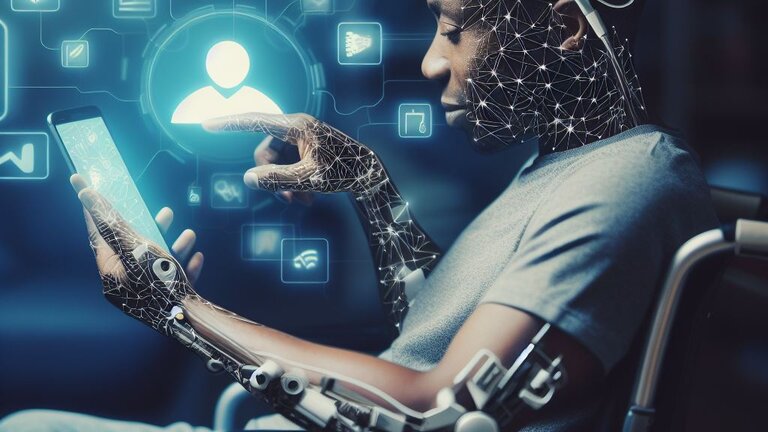Through the use of intelligent algorithms, voice recognition, and machine learning, AI-powered assistive tech can provide individuals with disabilities greater independence in their daily lives. From smart home automation systems to wearable devices that facilitate communication and mobility, these technologies have the potential to empower individuals and enable them to fully participate in society.

As we look towards the future, the convergence of AI and assistive technology holds immense potential for creating a more inclusive society, particularly for persons with disabilities. In this article, we will explore the role of AI and assistive tech in shaping a more inclusive future, discuss emerging technologies and future trends, and examine the potential impact on persons with disabilities in Kenya.
The Power of AI and Assistive Tech in Inclusion
Enhancing Accessibility and Independence
AI and assistive technology have the ability to break down barriers and enhance accessibility for persons with disabilities. Through the use of intelligent algorithms, voice recognition, and machine learning, AI-powered assistive tech can provide individuals with disabilities greater independence in their daily lives. From smart home automation systems to wearable devices that facilitate communication and mobility, these technologies have the potential to empower individuals and enable them to fully participate in society.
Bridging Communication Gaps
Communication is a fundamental aspect of human interaction, and AI can play a significant role in bridging communication gaps for individuals with disabilities. Natural language processing and machine learning algorithms can be used to develop speech-to-text and text-to-speech applications, enabling seamless communication between individuals with different communication needs. Such is the case with Signverse, that utilises AI and avatars to translate sign language to text and vice versa, enabling deaf persons to communicate with the hearing world seamlessly. This technology revolutionizes the way individuals with disabilities interact with others, breaking down barriers and fostering inclusivity.
Personalized Solutions for Unique Needs
One of the key advantages of AI and assistive technology is the ability to provide personalized solutions tailored to the unique needs of individuals with disabilities. Machine learning algorithms can analyze data and adapt to individual preferences, enabling assistive devices to learn and anticipate user requirements. This level of personalization ensures that individuals receive the support they need, enhancing their overall quality of life and promoting independence.
Emerging Technologies and Future Trends
Robotics and Prosthetics
Advancements in robotics and prosthetics are opening new horizons for individuals with physical disabilities. AI-powered robotic limbs offer a promising avenue, providing not only enhanced mobility and dexterity but also the potential for individuals to regain independence and actively participate in diverse activities. These cutting-edge technologies are rapidly evolving, with the capability to mimic natural movements and seamlessly integrate with the user's body.
Moreover, the integration of exoskeletons and bionic robots further expands the scope of possibilities. Exoskeletons, with their external wearable framework, contribute to improved strength and endurance, augmenting the user's physical abilities. On the other hand, bionic robots, equipped with advanced AI, offer innovative solutions by combining the precision of robotics with the adaptability required for real-world applications. This holistic approach to robotics and prosthetics signifies a transformative era for individuals with physical disabilities, ushering in not only enhanced functionality but also a more inclusive and integrated future.
Computer Vision and Object Recognition
Computer vision, coupled with AI algorithms, can enable devices to recognize and interpret visual information. This technology has the potential to benefit individuals with visual impairments by providing them with auditory cues or tactile feedback about their surroundings. From object recognition to navigation assistance, computer vision has the power to revolutionize the way individuals with visual impairments interact with the world. An example of this technology is the Orcam MyEye glasses.
Virtual Reality and Augmented Reality
Virtual reality (VR) and augmented reality (AR) technologies offer immersive experiences that can be harnessed to create inclusive environments. VR simulations can provide individuals with disabilities the opportunity to experience scenarios that may be challenging in real life, such as practicing mobility skills or navigating public spaces. AR applications can enhance accessibility by overlaying information and visual cues onto the physical environment, assisting individuals with various disabilities in their daily lives.
Potential Impact on Persons with Disabilities in Kenya
The transformative potential of AI and assistive technology in the lives of individuals with disabilities is substantial. By emphasizing inclusive technology and fostering innovation through spaces like Innovate Now and Senses Hub, the adoption of AI-powered assistive devices can be significantly accelerated. These innovation hubs provide an enabling environment for the development and refinement of cutting-edge solutions tailored to the unique challenges faced by individuals with disabilities in Kenya.
Moreover, the presence of dedicated IT training centres, exemplified by initiatives like the Next Step Foundation, further contributes to the successful integration of AI-powered assistive technologies. Through specialized training programs, these centres empower individuals with disabilities to harness the full potential of these technologies, fostering a greater sense of independence and self-efficacy.
In tandem, the localized development of assistive technologies ensures that solutions are not only technologically advanced but also culturally relevant. This approach enhances accessibility across various domains, including education, employment, and social engagement. Ultimately, by combining the forces of innovation spaces and targeted training initiatives, Kenya is poised to create a more inclusive and empowering landscape for individuals with disabilities, harnessing the benefits of AI and assistive technology to their fullest extent.
